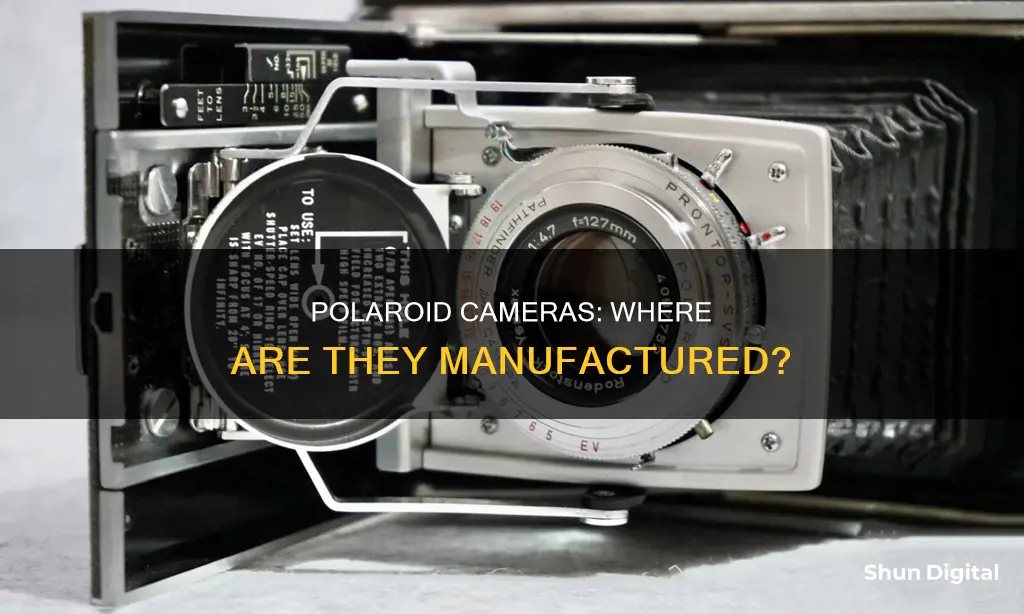
The Polaroid company, founded in 1937 by Edwin Land, is an American company best known for its instant film and cameras. The company's first camera, the Land Camera, was released in 1948, and since then, Polaroid has become a household name, with its products being used all over the world. However, the company suffered a long decline starting in the 1980s, leading to bankruptcy in the early 2000s. Despite this, Polaroid cameras remain iconic, and the brand has continued to release new instant camera models in recent years, manufactured in various locations around the world.
| Characteristics | Values |
|---|---|
| Country of origin | USA |
| Place of incorporation | Cambridge, Massachusetts |
| Founder | Edwin H. Land |
| Co-founder | George W. Wheelwright III |
| Year founded | 1937 |
| Year of first camera release | 1948 |
| Place of first sale | Jordan Marsh department store, Boston |
| Current owner | PLR IP Holdings, LLC |
| Current owner's nationality | Polish |
| Current headquarters | Minnetonka, Minnesota |
| Other office locations | Boston, New York, Toronto, Vienna, Berlin, Tokyo |
| Film production location | Enschede, Netherlands |
What You'll Learn
- Polaroid Corporation was founded in Cambridge, Massachusetts, in 1937 by Edwin Land and George Wheelwright
- Edwin Land's daughter, Jennifer, sparked the idea for the first instant camera
- The first instant camera, the Land Camera, was unveiled in 1947 and sold to the public in 1948
- Polaroid cameras and film are now manufactured by Polaroid BV, formerly known as the Impossible Project
- Polaroid filed for bankruptcy in 2001 due to its failure to embrace digital technology

Polaroid Corporation was founded in Cambridge, Massachusetts, in 1937 by Edwin Land and George Wheelwright
The Polaroid Corporation was founded in Cambridge, Massachusetts, in 1937 by Edwin Land and George Wheelwright. The company was born out of Land's self-guided research in light polarisation, which he began in 1926, after his freshman year at Harvard University. Land returned to Harvard in 1929 and, with the help of Wheelwright, a young physics instructor at the university, began producing small sheets of polarising material. In 1932, the pair founded Land-Wheelwright Laboratories to further explore the invention's practical applications.
In 1933, Land and Wheelwright incorporated their laboratory, concentrating on developing polarising material for no-glare car headlights and windshields. However, despite their enthusiasm, commercial success eluded them during the Great Depression. It was not until 1935 that the company received its first financial break: a $10,000 order from Eastman Kodak for photographic polarising filters. By this time, the polarising material had been dubbed “Polaroid”, a name that would later be adopted by the company.
In 1937, Land formed the Polaroid Corporation to acquire the operations he had started with Wheelwright. Eight original shareholders provided $375,000 in funding, investing in Land's ideas and giving him control of the company for the next decade. The company's initial market was in polarised sunglasses, and it soon began employing polarisation in products such as 3D movies and protective goggles for military dogs. During World War II, Polaroid designed and manufactured various products for the armed services, including an infrared night-viewing device.
After the war, Land began researching instantaneous developing film, and in 1947, the company introduced the Polaroid Land Camera, which delivered a finished sepia-toned print 60 seconds after exposure. This marked the debut of instant photography, which would become the bulk of Polaroid's income. Over the next few decades, Polaroid continued to innovate, introducing colour film, the compact SX-70 camera, and instant motion pictures.
Land stepped down as CEO in 1980 and resigned from the company in 1982, passing away in 1991. The company he founded continued to develop new products and diversify its offerings, but it struggled to keep up with emerging technologies such as digital cameras. Polaroid filed for bankruptcy protection in 2001 and was eventually sold, with its brand and assets changing hands multiple times. Despite these challenges, the Polaroid brand survives today, licensing its name to various consumer electronics products.
Salvaging Your Camera After a Battery Leak
You may want to see also

Edwin Land's daughter, Jennifer, sparked the idea for the first instant camera
Edwin Land, the co-founder of the Polaroid Corporation, was inspired to create the first instant camera by his daughter, Jennifer. On a family trip to Santa Fe, New Mexico, in 1943, Land took a photo of his three-year-old daughter. When she asked why she couldn't see the picture right away, he explained the process of developing film and printing photos. Jennifer, a girl ahead of her time, responded with: "That's stupid. Why can't I see the photos instantly?"
Land, an avid photographer and scientist, was intrigued by the idea of creating an instant camera. Within an hour of his daughter's question, he had conceived of the Polaroid instant camera. This idea built upon his previous research on polarizers and the properties of light. Land understood that he would need to create a tiny darkroom inside the camera, allowing for the simultaneous development of the negative and positive image.
The first Polaroid instant camera, the Land Camera, was demonstrated to the Optical Society of America in February 1947 and commercially released in late 1948. The initial batch of sixty cameras sold out on the first day, marking the beginning of a revolution in photography.
Candid Camera Mode: Periscope's Secret Weapon
You may want to see also

The first instant camera, the Land Camera, was unveiled in 1947 and sold to the public in 1948
The Land Camera was a self-developing film camera that revolutionised the world of photography. Prior to its invention, cameras used roll film, which had to be taken to shops for development. Land's creation, however, introduced "one-step photography," allowing users to view images immediately after capture. The camera contained a roll of positive paper with a pod of developing chemicals at the top of each frame. After taking a photo and turning a knob, the exposed negative and paper were forced through rollers, spreading the reagents evenly between the layers as they were pushed out of the camera. A built-in paper cutter then trimmed the paper, and after about a minute, the layers could be peeled apart to reveal the final image.
The first commercially available model of the Land Camera was the Model 95, released on November 26, 1948. The camera retailed for $89.75 (approximately $886 in today's money) and only 50 units were initially available for sale at the Jordan Marsh department store in Boston. Despite the limited stock, the cameras sold out in a single day, propelled by enthusiastic press reviews and consumer demand. The Model 95 remained on the market for the next fifty years, with the camera making over $5 million in sales in its first year.
The Land Camera served as the prototype for Polaroid cameras for the next fifteen years. In 1963, Polaroid introduced the Polacolor film, enabling the production of colour photographs. This colour process involved pulling two tabs from the camera, with the second tab pulling the film sandwich through the rollers to develop outside the camera. The instant colour process was more complex than black-and-white photography, involving a negative with three layers of emulsion sensitive to blue, green, and red light.
GoPro Charging Time: How Long Until Your Camera's Ready?
You may want to see also

Polaroid cameras and film are now manufactured by Polaroid BV, formerly known as the Impossible Project
Polaroid BV is a Dutch photography and consumer electronics company that produces new instant cameras under the Polaroid brand name, as well as wireless speakers and other accessories. The company was founded as a manufacturer of discontinued film for Polaroid Corporation instant cameras. In addition to film, Polaroid manufactures SX-70 and 600 film, i-Type film, Go film, and large format 8x10 film. The company has offices in Vienna, Berlin, New York City, and Tokyo, and has licensed its name to stores in Germany, Spain, and London.
The story of Polaroid's instant photography began almost a hundred years ago and the company played an integral part in the evolution of photography during the twentieth century. With the invention of the Polaroid camera, for the first time in history, the average person could take a photo and hold the result in their hand almost instantaneously. Polaroid cameras and other instant cameras have enjoyed something of a resurgence in recent years as nostalgia for antiquated technology continues to grow.
Charging Your ADT Doorbell Camera: How Long Does It Take?
You may want to see also

Polaroid filed for bankruptcy in 2001 due to its failure to embrace digital technology
The Polaroid Corporation, founded in 1937, was an American company best known for its instant film and cameras. The company enjoyed decades of success, becoming synonymous with instant photography. However, in 2001, Polaroid filed for bankruptcy, unable to adapt to the digital revolution.
Early Success
Polaroid was founded by Edwin H. Land and George W. Wheelwright III in Cambridge, Massachusetts. Land, a scientist, invented a lens that could polarize light, making light rays move in parallel. This technology laid the foundation for instant photography, glare-free sunglasses, and goggles used by World War II pilots to spot submarines.
Under Land's leadership, Polaroid thrived, becoming an industry leader in photography. By the 1960s, Polaroid's sales reached $400 million, and its revenue peaked at $3 billion in 1991. The company was so confident in its position that when Kodak announced instant film cameras in 1976, Polaroid sued and won, receiving $909.5 million in damages.
Failure to Embrace Digital Technology
Despite its early success, Polaroid struggled to adapt to the digital age. The company's refusal to diversify its product offerings and embrace digital technology ultimately led to its downfall.
Even as early as the 1960s, Polaroid's research and development department was involved in digital photography. By the 1970s, the company had a 15% share of the US camera market, and its research efforts resulted in dozens of patents for instant imaging solutions. However, Polaroid failed to capitalize on its own innovations.
In the late 1990s, Polaroid was the top seller of digital cameras, yet the company's executives clung to the belief that customers would always prefer hard-copy prints. This mindset resulted in a failure to innovate and adapt to changing consumer demands.
Polaroid's aversion to innovation was evident in its slow response to the growing trend of digital photography. The company developed functional digital cameras as early as 1996 but never released them, concerned about disappointing customers with low-quality images. This hesitation allowed competitors like Canon to gain a foothold in the market.
Bankruptcy and Aftermath
In October 2001, Polaroid filed for Chapter 11 bankruptcy protection. The company's assets were sold, and it officially changed hands multiple times before being acquired by Polish billionaire Wiaczesław Smołokowski in 2017. The new owners rebranded, first as Polaroid Originals and then simply as Polaroid in 2020, focusing on instant film and cameras.
Polaroid's bankruptcy is a cautionary tale of a company that failed to adapt to technological advancements. Despite its early success and innovative roots, Polaroid's inability to embrace digital technology and diversify its offerings ultimately led to its decline.
Editing Midtones in Camera Raw: A Step-by-Step Guide
You may want to see also
Frequently asked questions
The first Polaroid camera was made in Cambridge, Massachusetts, USA, in 1948. The company continued to manufacture cameras in the US until the early 2000s, when production moved to China and other low-wage countries.
The Polaroid camera was invented by Edwin Herbert Land, who founded the Polaroid Corporation in 1937.
The first Polaroid camera, the Land Camera, was unveiled in February 1947 and went on sale in 1948.
The first Polaroid camera was called the Land Camera, named after its inventor. It produced a finished sepia-toned print 60 seconds after exposure.
Yes, Polaroid cameras are still made. The company filed for bankruptcy in 2001 and has changed hands several times since then, but it continues to manufacture new instant cameras under the Polaroid brand name.







